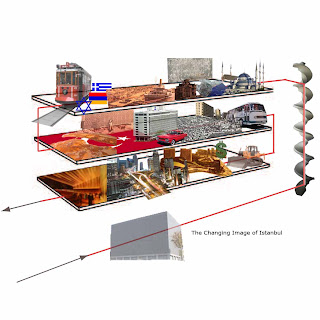
This milieu is for exchanging and disseminating thoughts in the context of 'Urban Representation: Remapping Istanbul' course given by Ipek Yada Akpinar, Banu Tomruk, Evren Aysev and Burcu Yiğit Turan at ITU Bu platform, İTÜ'de İpek Yada Akpınar, Banu Tomruk, Evren Aysev ve Burcu Yiğit Turan tarafından yürütülen 'Urban Representation: Remapping Istanbul' dersinin, düşünce alış-verişi ve yayımı için bir ortamdır.
Tuesday 30 November 2010
Neighborhood Mapping

patrick franke mapping 3 + revised mapping 1
revised mapping 1

the revised mapping adds a layer of clarification and notation. major additions to the mapping include delineation of the route of travel (and deviation from the route) as well as start and end points. the mapping attempts to be expressive of the neighborhood's qualities of topography, movement, height, verticality, and flexibility.
mapping 3
 mapping 3 seeks to examine the museum building as a container of history. this unique space is then distinctly different from its surroundings. the mapping is an understanding of the difference between time moving inside the museum and outside it.
mapping 3 seeks to examine the museum building as a container of history. this unique space is then distinctly different from its surroundings. the mapping is an understanding of the difference between time moving inside the museum and outside it.Wednesday 24 November 2010
Thursday 18 November 2010
Wednesday 10 November 2010
Tuesday 9 November 2010
Monday 8 November 2010
mental-mapping of metro-line

Sunday 7 November 2010
The "gravitation-centre" of Istanbul

The Center of Istanbul
This Mapping is showing the „Gravitation“-Citycentre of Istanbul, according to the population of the districts and there position. The positions of the districts are also points. In this calculation the whole population of a district is in one point, which also can be seen as the gravitation centre of the district. So the question is: where is the emphasis of Istanbul?
To answer this question, a not really difficult calculation must be done. You need a city map for tracking the districts into a xy-coordinate-system and the populations – the masses of the gravitation. After that, a really interesting answer occurred:
The (gravitation) Center of Istanbul is in Fatih, near the golden Horn - a little bit West of Atatürk Boulevard
This is interesting, because it looks like the gravitation-centre hasn’t changed a lot since the last 2000 years, although developments of the last decades have changed the urban structure of Istanbul a lot.
There are also weaknesses in the model. The location of the district-gravitation-points where found by estimation. For the bigger districts the points are less exact, but these districts have also less population. The bigger remaining question is how the population of Istanbul really distributed, because the Statistics which are used are just showing the official population.(circa 13 mill.)
This kind of mapping is a statistical tool to give an overview of the spatial distribution of a population. Often it is interesting to map the change of this population-emphasis. For example the map below is showing the population-gravity-point (Bevölkerungsschwerpunkt) in the history of the United States. It is a constant drift towards the south-west.
Mental (visual) mapping of Istanbul and my neighbourhood

In the first mapping I wanted to keep it as simple and abstract as possible. I wanted to explore how less it’s possible to reduce the content of visual communication = mapping. Of course it’s possible to add more information, but for the question, where my neighbourhood is circa located it is enough. I believe, in a way, this is also how our/mine mind works, when we/I want to get orientation in a city. For human beings there is an deep demand to get an sudden simple orientation. If we can’t get this orientation we sometimes feel uncomfortable or insecure, or in another way: we are used to make our one mental mapping, ourself reference topology in short time.

The second image is a mental mapping of my neighbourhood. In fact it is just the street i’m living, because this street is like an important axis for my mental reference in Istanbul. It connects the Bosporus at Findikli with the Taksim Square. Not that this is the only street I know in Istanbul, but it’s like a milestone in my mental-mapping of the city. The different directions from there are mentioned by the different places like “Besiktas, “Talabasi”, …

In my personal mapping there are a lot of shops and other kind of consume related establishments. In the area there are not so many landmarks, so i orientate myself mostly by streetlevel establishments.
Maybe more interesting are the things I don’t mention in my mapping. For example a church or a carpark. Also the fact that i am an foreign student in the city, who doesn’t know the people in the street is important. For example i didn’t mention person-related things like “Ali’s house”, “place of the old mans” etc.
I also wanted to mention, that we all have learned to orientate in urban spaces. Maybe like human beings in the past, who orientated themselves through forest and nature, we also have to find ways to orientate. For example mapping tools like the open source Google systems are playing an important role at the moment.
Wednesday 3 November 2010
Monday 1 November 2010
Obstruction_ Closing the quarter of Tarlabaşı
















